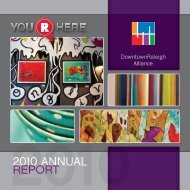Pedestrian Count Study - Downtown Raleigh Alliance
Pedestrian Count Study - Downtown Raleigh Alliance
Pedestrian Count Study - Downtown Raleigh Alliance
You also want an ePaper? Increase the reach of your titles
YUMPU automatically turns print PDFs into web optimized ePapers that Google loves.
3. Methodology<br />
3.1 Summary of Methodology<br />
The methodology for the <strong>Raleigh</strong> <strong>Pedestrian</strong> <strong>Count</strong> was derived from<br />
the National Bicycle and <strong>Pedestrian</strong> Documentation project (NBPD)<br />
standardized procedures. <strong>Count</strong> forms and incremental recordings mirror<br />
NBPD models for tracking pedestrian activity.<br />
The NBPD is a joint national effort by the Institute of Transportation<br />
Engineers (ITE) <strong>Pedestrian</strong> & Bicycle Council, and Alta Planning + Design.<br />
The NBPD identifi es a consistent count and survey methodology and<br />
count dates, collects count and survey data nationwide, and analyzes<br />
the data to identify walking and bicycling trends and patterns.<br />
Data regarding where bicyclists and pedestrians live, trip purpose, trip<br />
length, travel frequency, alternate modes, factors for route choice,<br />
seasonal behavior, desires for improvements, and demographic data,<br />
can help identify correlations and causations within travel behavior,<br />
leading to more informed modeling, along with facilities and programs<br />
that properly respond to community needs and conditions.<br />
This study does not follow standardized procedures for selecting count<br />
locations, as the <strong>Downtown</strong> <strong>Raleigh</strong> <strong>Alliance</strong> (DRA) selected this study’s<br />
locations for specifi c reasons related to economic development.<br />
However, the information collected will be added to the NBPD’s<br />
database, contributing to the national data collection effort and serving<br />
as a reference for other count studies. In the future, additional studies<br />
conducted in <strong>Raleigh</strong> including surveying methods established by the<br />
NBPD, will enable an in-depth analysis of travel patterns in the downtown<br />
area.<br />
3.2 <strong>Count</strong> Locations<br />
<strong>Count</strong> locations were established by the DRA. The method for selecting<br />
each location was determined by interest in pedestrian volume during<br />
specifi c times of day. For the purpose of this study, pedestrian activity<br />
(further defi ned as “bodies on the sidewalk”) was counted in the Core<br />
Business District (Fayetteville Street District), as well as two late night/<br />
entertainment districts: the Warehouse District and Glenwood South.<br />
<strong>Pedestrian</strong> <strong>Study</strong> | Methodology-3.3







